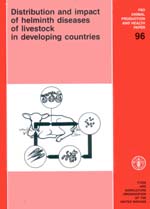
FAO ANIMAL PRODUCTION AND HEALTH PAPER 96
 |
Distribution and impact of helminth diseases of livestock in developing countries |
H. J. Over
J. Jansen
and
P. W. van Olm
Lelystad, the Netherlands
The designations employed and the presentation of material in this publication do not imply the expression of any opinion whatsoever on the part of the Food and Agriculture Organization of the United Nations concerning the legal status of any country, territory, city or area or of its authorities, or concerning the delimitation of its frontiers or boundaries.
M-27
ISBN 92-5-103166-5
All rights reserved. No part of this publication may be reproduced, stored in a retrieval system, or transmitted in any form or by any means, electronic, mechanical, photocopying or otherwise, without the prior permission of the copyright owner. Applications for such permission, with a statement of the purpose and extent of the reproduction, should be addressed to the Director, Publications Division, Food and Agriculture Organization of the United Nations, Viale delle Terme di Caracalla, 00100 Rome, Italy.
The designations employed and the presentation of material in this publication do not imply the expression of any opinion whatsoever on the part of the Food and Agriculture Organization of the United Nations concerning the legal status of any country, territory, city or area, or of its authorities, or concerning the delimitations of its frontiers or boundaries.
The designations “developed” and “developing” do not necessarily express a judgement about the stage reached by a particular country or area in the development process.
This document has been prepared on the basis of the valuable work done by Drs. Hans J. Over and J. Jansen and Mr. P. W. van Olm. The document has been further reviewed by the FAO technical staff.
FAO gratefully acknowledge the contribution of the above persons.

FOOD AND AGRICULTURE ORGANIZATION OF THE UNITED NATIONS
Rome, © FAO 1992
Hyperlinks to non-FAO Internet sites do not imply any official endorsement of or responsibility for the opinions, ideas, data or products presented at these locations, or guarantee the validity of the information provided. The sole purpose of links to non-FAO sites is to indicate further information available on related topics.
2. DATA PROCESSING AND REFERENCE HANDLING
3. GEOGRAPHICAL DISTRIBUTION OF TREMATODE INFECTIONS
3.1. Bloodflukes
3.2. Gastro-intestinal and rumen flukes
3.3. Liverflukes
3.4. Miscellaneous trematodes
4. GEOGRAPHICAL DISTRIBUTION OF CESTODE INFECTIONS
4.1. Anaplocephalidae
4.2. Echinococcus
4.3. Cysticercus
5. GEOGRAPHICAL DISTRIBUTION OF NEMATODE INFECTIONS
5.1. Lungworms
5.2. Gastro-intestinal nematodes
5.3. Filaroids
5.4. Miscellaneous nematodes
6. HELMINTH INFECTIONS IN POULTRY AND DUCKS
7. THE IMPACT OF HELMINTH INFECTIONS IN DEVELOPING COUNTRIES
ANNEX VII. LIVERFLUKES, AMERICA
ANNEX VIII. LIVERFLUKES, AFRICA
ANNEX XI. ANAPLOCEPHALIDS, AMERICA
ANNEX XII. ANAPLOCEPHALIDS, AFRICA
ANNEX XIII. ANAPLOCEPHALIDS, ASIA
ANNEX XIV. ECHINOCOCCUS, AMERICA
ANNEX XV. ECHINOCOCCUS, AFRICA
ANNEX XVII. CYSTICERCUS, AMERICA
ANNEX XVIII. CYSTICERCUS, AFRICA
ANNEX XX. MISC. CESTODES, ASIA
ANNEX XXIV. G-I NEMATODES, AMERICA
ANNEX XXV. G-I NEMATODES, AFRICA
ANNEX XXVI. G-I NEMATODES, ASIA
ANNEX XXVII. FILAROIDS, AMERICA
ANNEX XXVIII. FILAROIDS, AFRICA
ANNEX XXX. MISC. NEMATODES, AMERICA
ANNEX XXXI. MISC. NEMATODES, AFRICA
ANNEX XXXII. MISC. NEMATODES, ASIA
ANNEX XXXIII. POULTRY, ALL COUNTRIES
ANNEX XXXIV. DUCKS AND PIGEONS, AMERICA
ANNEX XXXV. DUCKS AND PIGEONS, ASIA
ANNEX XXXVI. IMPACT HELMINTHS, AMERICA
ANNEX XXXVII. IMPACT HELMINTHS, AFRICA
ANNEX XXXVIII. IMPACT HELMINTHS, ASIA
The importance of animal diseases as a constraint in the development of the livestock industry in the developing countries is well recognised. A number of major bacterial, viral and protozoan diseases have been and still are responsible for significant losses which reduce the much needed increase in productivity from taking place. Considerable progress has, however, been made in the control of some of these more dramatic diseases and the significance of production losses caused by less visible chronic diseases is becoming more evident than before. This is particularly true for the infections of livestock with helminths (liver flukes, lungworms, gastro-intestinal nematodes).
FAO is aware that the control of helminth infections up till now has received a lot less attention than has the control of the major epizootic infectious livestock diseases and is in the process of establishing a programme for the control of helminth infections.
The development of control programmes should be based on a thorough understanding of the epidemiology of the parasites and a reliable estimation of production losses. This information may not be easily available or the existence of previously accumulated data may not be known to scientists in developing countries. FAO, therefore, decided to create a database of existing information on helminth infections in the developing countries. The “Helminth Inventory” is a compilation of data on helminths published during the last 15 years, extracted from the four major agricultural and medical databases covering the world literature on the subject.
The numbered references are organized according to region and parasite group which make it easy to identify existing baseline data on a certain parasite in a certain region. It is the intention to update this inventory regularly. The system will be further developed on disk enabling the user to combine host -parasite - geographical region and extract existing references including an abstract for each reference.
FAO hopes that this compilation of data will be a useful tool for the Veterinary Services and Research Institutes when considering whether the existing baseline data are sufficient for implementation of control programmes or if that is not the case help in establishing research priorities.
Dr. E. P. Cunningham
Director
Animal Production and
Health Service, FAO